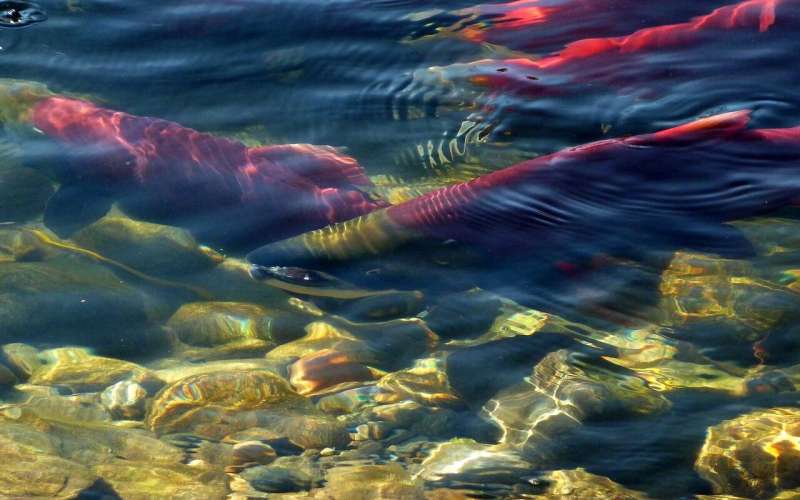Washington dam removal means 37 more miles of salmon habitat restored

Washington's dam-busting summer is still rolling, with two more dams coming down on the Pilchuck River, opening 37 miles of habitat to salmon for the first time in more than a century.
The $2 million dam removal project is a collaboration between the City of Snohomish and Tulalip Tribes, and will benefit multiple species of salmon, including threatened chinook salmon, crucial food for endangered southern resident killer whales.
It's the state's second dam teardown project in two months. In July, the city of Bellingham blew up its Nooksack Diversion Dam on the Middle Fork of the Nooksack River, opening 16 miles of habitat for salmon, including chinook.
In each case, dam removal was the practical solution to the problem of old infrastructure that no longer served its purpose and was too costly to either maintain or bring up to modern standards, either for fish, or water supply. Both the Pilchuck and Nooksack dams were for water diversion.
Steve Schuller, city administrator and utility general manager for the city of Snohomish, received direction from the City Council in 2014 to get the city out of the water supply business for the first time in more than 100 years.
The reason was simple: Paying for legally required upgrades to the city's water supply infrastructure was going to be more expensive for city residents than buying water from Everett, which was already supplying water for the north half of town.
The math was easy—but for a small city, taking down a 10-foot-high, 60-foot-plus-wide concrete dam, the larger of the two on the river built for water supply, was daunting, Schuller said.
That's where a crucial assist from the Tulalip Tribes came in.
"They were the ones with the expertise," said Schuller, who approached the tribe to ask for help with taking out the dams.
The larger dam had a fish ladder, but it clogged with sediment and did not function well, mostly blocking a third of habitat formerly available to salmon in the river, and all of the best of it.
The two governments signed an agreement in 2018 under which the tribes agreed to take the lead on taking both dams out.
"We developed this wonderful partnership—they are just phenomenal," Schuller said of the tribes. "There are three major benefits from this project. One is for the ratepayers, the other is the environmental benefit for the region. The neat surprise is the relationship our city has built."
The project was a natural, said Brett Shattuck, restoration ecologist for the Tulalip Tribes.
The Pilchuck, a tributary of the Snohomish, is in a culturally and environmentally important watershed for the tribes. While the Pilchuck is significantly altered by development in its lower reaches, its headwaters are largely intact, mostly in publicly owned timberland, and ideal for salmon, Shattuck said.
Caught between the pressures of climate change and population growth in Snohomish County, the tribes are working urgently to repair habitat to give salmon a chance at survival into the future.
Historically, about 12,000 chinook came back to the Pilchuck. Today, on average, just 100 come back. Last year, the worst on record, only 50 did. How many more will eventually come home is hard to say, but with a third more habitat to use with the dams out, the tribes are hoping for a big boost, Shattuck said.
Funding for the project was provided by a variety of sources, including the Paul G. Allen Family Foundation, the Tulalip Tribes the city of Snohomish, and state and federal salmon-recovery funds.
Construction equipment operators last week clawed at what was left of the upper of the two dams, built in 1912. The lower one, built in 1932, was already gone, with only a scar on the bedrock left to show it had ever been there.
Ryan Miller is the environmental liaison in the Treaty Rights Office for the Tulalip Tribes Natural and Cultural Resources department. A descendant of ancestors who used to live in winter villages along the Pilchuck, Miller watched contractors haul away load after load of debris, pleased to see the takedown happening so fast.
If all stays on schedule, the river, green and clear, will be back in its original channel and free flowing again within weeks.
"From here, it only gets better," Miller said, looking upstream at the sparkling river, overhung with a deep forest. The tall trees cast lush shadows on water laughing over rocks smoothed round by the current.
So many things have affected the fish runs in the past 100 years, this was just another, but it was so damaging," Miller said.
He remembers watching salmon smash into the face of the dam.
In addition to boosting chinook, coho, steelhead, bull trout and other aquatic species also will benefit.
"This is one of these really rare opportunities," Miller said. "This is an opportunity to help salmon as well as tribal and nontribal fishermen, and orcas."
The project is yet another recent major undertaking in the Snohomish River basin for salmon, including the removal of dike infrastructure led by Snohomish County at Smith Island to reestablish historic tidal marshlands, and Tulalip Tribes' Qwuloolt estuary restoration on the Snohomish River near its outlet to Puget Sound at Marysville.
Now, two dam removals are getting done on Puget Sound rivers in as many months in Washington's biggest dam-busting binge since the Condit, Elwha and Glines Canyon dam removals all got underway in September and October of 2011.
"It's great to see," Miller said. "It just magnifies the benefits."
©2020 The Seattle Times
Distributed by Tribune Content Agency, LLC.


















